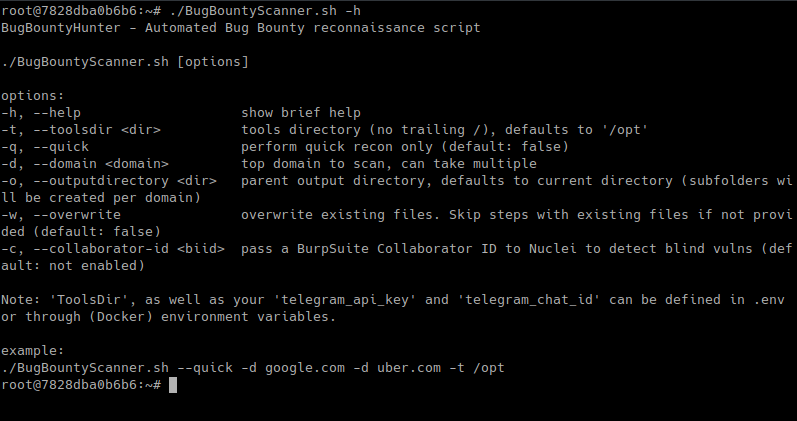BugBountyScanner – Script and Docker Image for Reconnaissance. A Bash script and Docker image for Bug Bounty reconnaissance, intended for headless use. Low on resources, high on information output.
Helpful? BugBountyScanner helped you net a bounty?
Description
It’s recommended to run BugBountyScanner from a server (VPS or home server), and not from your terminal. It is programmed to be low on resources, with potentially multiple days of scanning in mind for bigger scopes. The script functions on a stand-alone basis.
You can run the script either as a docker image or from your preferred Debian/Ubuntu system (see below). All that is required is kicking off the script and forgetting all about it! Running the script takes anywhere in between several minutes (for very small scopes < 10 subdomains) and several days (for very large scopes > 20000 subdomains). A ‘quick mode’ flag is present, which drops some time-consuming tasks such as vulnerability identification, port scanning, and web endpoint crawling.
Installation
Docker Hub Link: https://hub.docker.com/r/chvancooten/bugbountyscanner. Images are generated automatically for both the Dev branch (:dev tag) and the Master branch (:latest tag).
You can pull the Docker image from Docker Hub as below.
docker pull chvancooten/bugbountyscanner docker run -it chvancooten/bugbountyscanner /bin/bash
Docker-Compose can also be used.
version: "3"
services:
bugbountybox:
container_name: BugBountyBox
stdin_open: true
tty: true
image: chvancooten/bugbountyscanner:latest
environment:
- telegram_api_key=X
- telegram_chat_id=X
volumes:
- ${USERDIR}/docker/bugbountybox:/root/bugbounty
# VPN recommended :)
network_mode: service:your_vpn_container
depends_on:
- your_vpn_container
Alternatively, you can build the image from source.
git clone https://github.com/chvancooten/BugBountyScanner.git cd BugBountyScanner docker build .
Manual
If you prefer running the script manually, you can do so.
The script has been built on -and tested for- Ubuntu 20.04. Your mileage may vary with other distro’s, but it should work on most Debian-based installs (such as Kali Linux).
git clone https://github.com/chvancooten/BugBountyScanner.git cd BugBountyScanner cp .env.example .env # Edit accordingly chmod +x BugBountyScanner.sh setup.sh ./setup.sh -t /custom/tools/dir # Setup is automatically triggered, but can be manually run ./BugBountyScanner.sh --help ./BugBountyScanner.sh -d target1.com -d target2.net -t /custom/tools/dir --quick
Usage
Use –help or -h for a brief help menu.
root@dockerhost:~# ./BugBountyScanner.sh -h BugBountyHunter - Automated Bug Bounty reconnaissance script
./BugBountyScanner.sh [options]
options:
-h, –help show brief help
-t, –toolsdir tools directory (no trailing /), defaults to ‘/opt’
-q, –quick perform quick recon only (default: false)
-d, –domain top domain to scan, can take multiple
-o, –outputdirectory parent output directory, defaults to current directory (subfolders will be created per domain)
-w, –overwrite overwrite existing files. Skip steps with existing files if not provided (default: false)
-c, –collaborator-id pass a BurpSuite Collaborator BIID to Nuclei to detect blind vulns (default: not enabled)
Note: ‘ToolsDir’, ‘telegram_api_key’ and ‘telegram_chat_id’ can be defined in .env or through Docker environment variables.
example:
./BugBountyScanner.sh –quick -d google.com -d uber.com -t /opt
Features
- Resource-efficient, suitable for running in the background for a prolonged period of time on a low-resource VPS, home server, or Raspberry Pi
- Telegram status notifications with per-command results
- Extensive CVE and misconfiguration detection with Nuclei (optionally with detection of blind vulnerabilities via Burp Collaborator)
- Subdomain enumeration and live webserver detection
- Web screenshotting and crawling, HTML screenshot report generation
- Retrieving (hopefully sensitive) endpoints from the Wayback Machine
- Identification of interesting parameterized URLs with Gf
- Enumeration of common “temporary” and forgotten files with GoBuster
- Automatic detection of LFI, SSTI, and Open Redirects in URL parameters
- Subdomain takeover detection
- Port scanning (Top 1000 TCP + SNMP)
- ‘Quick Mode’ for opsec-safe (ish) infrastructure reconnaissance
GitHub
- https://github.com/chvancooten/BugBountyScanner




nice
nice